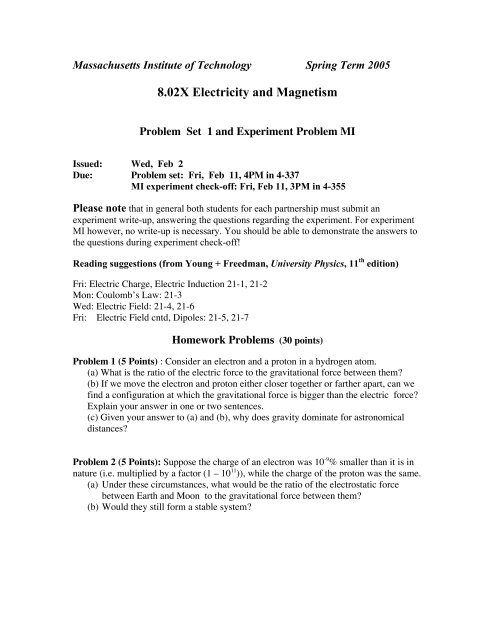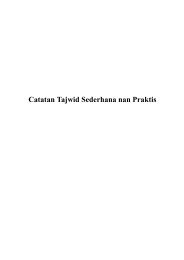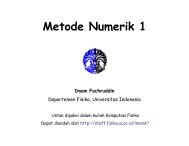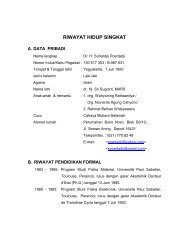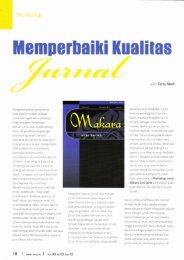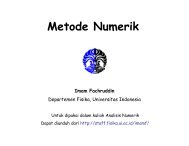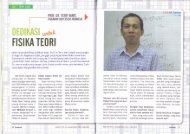8.02X Electricity and Magnetism
8.02X Electricity and Magnetism
8.02X Electricity and Magnetism
You also want an ePaper? Increase the reach of your titles
YUMPU automatically turns print PDFs into web optimized ePapers that Google loves.
Problem 3 (5 points):Consider the configuration shown below, with a positive charge Q 0 at position x 0 =0 <strong>and</strong>another positive charge Q 1 at position x 1 along the x-axis .(a) At which position x 2 could a third positive charge charge Q 2 be added, such thatthe total force on Q 0 is 0? Give two examples of x 2 <strong>and</strong> corresponding Q 2 , interms of x 0 , x 1 , Q 0 <strong>and</strong> Q 1 (or a subset of these variables).(b) Qualitatively, describe what would happen if Q 0 was displaced by a smalldistance Dx from x 0 =0 to x=Dx <strong>and</strong> then released (two sentences max.)?Q 0 > 0Q 1 > 0x 0 =0x =x 1Problem 4 (5 Points): Young + Freedman, Exercise 21.9Problem 5 (5 Points): Young + Freedman, Exercise 21.25Problem 6 (5 Points): Young + Freedman, Exercise 21.31
Experiment Meter IntroductionDue Date: Check-off by Friday 3PM Feb 11 in lab 4-355. To satisfy the check-off for the ExperimentMeter Introduction you must do the following tasks. Please read the Check-off <strong>and</strong> Grading Policyh<strong>and</strong>outLab Hours: Mondays: 3-5 pm, Tuesday: 7:30-9:30 pm, Wednesday: 7:30-9:30 pm, Thursday: 3-5pm, Fridays: 12-3 pmSoldering, <strong>and</strong> Clip Leads:• Make Two Clip Leads• Solder Alligator Clips to your Multimeter Leads for each Multimeter• Solder Alligator Clips on your Transformer Leads• Put Battery in MultimeterMeasuring Voltage, Resistance <strong>and</strong> Current with the Multimeter:• Measure the resistance of the 20 resistor• Measure the voltage of the AA cell• Measure the current in a simple circuitMeasure the resistance of the 20 resistor: In order to zero the meter, short the test leads byconnecting them together. Then adjust the OHMS ADJUST knob (located to the left of center of theMMM) so that the meter reads 0 ohms; the needle is then at its maximum deflection.Set the range selector switch on the MMM to the RX1 range. Connect the test leads to the resistor. Measurethe resistance. You may want to make other resistance measurements. For example make a thick line with alead pencil <strong>and</strong> measure the resistance of the mark.Measure the voltage of the AA cell: Set the range selector switch on the MMM to the 5 DCV range. Placethe AA cell in the battery holder. Connect the test leads to the leads from the holder. Measure the voltage.Measure the current in a simple circuit: First set the range selector switch on the MMM to the 250mDCA range. Make a simple circuit consisting of the 20 resistor, the AA cell, <strong>and</strong> the MMM. You can dothis by connecting the red lead of the MMM to the red lead (plus,+) of the AA cell holder. Use a clip leadto connect the black lead (minus,-) of the AA cell holder to one end of the 20 resistor. Connect the blacklead of the MMM to the other end of the 20 resistor. Measure the current in the circuit. What effect doyou think the MMM has on the circuit?
8.02x – Problem Set 1 SolutionsProblem 1 (5 points)a) The ratio of the electric force to the gravitational force for an electron<strong>and</strong> a proton in a hydrogen atom is∣ F e ∣∣∣∣ =F g=k eer 2= k e 2= (1)G mempG mr 2 e m p9.0 × 10 9 N · m 2 /C 2 (1.6 × 10 −19 C) 26.67 × 10 −11 N · m 2 /kg 2 (9.1 × 10 −31 kg)(1.67 × 10 −27 kg) ≈ 2 × 1039 .b) In a), we have seen that the ratio of the forces does not depend on thedistance, because both Newton’s gravitational law <strong>and</strong> Coulomb’s law have r −2dependence. Therefore, the ratio F e /F g doesn’t change with distance.c) The universe is charge neutral on large scales. Therefore, there is nonet electromagnetic force on astronomical distances. However, gravitationalmass adds up, <strong>and</strong> gravitation is only an attractive (<strong>and</strong> long-distance) force, itdominates.Problem 2 (5 points)a) The ratio of the forces would be∣ F e ∣∣∣∣ = k Q E Q M. (2)F g G M E M MWe need to estimate the number of protons (<strong>and</strong> electrons) in Earth <strong>and</strong> inthe Moon. We assume protons contribute to roughly half the mass (neutronsare the other part, <strong>and</strong> electrons are 1000 times lighter). Therefore, the Earthhas approximately N E ≈ (M E /m p )/2 protons. On the other h<strong>and</strong>, the Moonhas approximately N M ≈ (M M /m p )/2 protons. Assuming the electrons’ chargeis (1 − 10 −11 ) times the proton charge, the Earth would carry a charge Q E ≈eN E × 10 −11 , <strong>and</strong> the moon would have charge Q M ≈ eN M × 10 −11 . The ratioof the forces would then be( ) ( )∣ F e ∣∣∣∣ = k ME2m pe × 10 −11 MM2m pe × 10 −11 = k e 2× 10 −22 = (3)F g G M E M MG=4m 2 p9.0 × 10 9 N · m 2 /C 26.67 × 10 −11 N · m 2 /kg 2 (1.6 × 10 −19 C) 2(1.67 × 10 −27 kg) 2 × 10−22 ≈ 1 × 10 14 .1
) This system would be highly unstable, the repulsive electrostatic forcewould tear them apart. It would be 14 orders higher than the gravitationalattractive force!Problem 3 (5 points)a) The simplest example is placing another positive charge Q 2 = Q 1 symetricallyat x 2 = −x 1 . Another example is placing a bigger second charge withmagnitude Q 2 = 4Q 1 at x 2 = −2x 1 .We can also derive a general rule for finding Q 2 <strong>and</strong> x 2 . Let us assume thenet force on charge Q 0 is zero. How do Q 2 <strong>and</strong> x 2 depend on Q 1 <strong>and</strong> x 1 ?|F 10 | = |F 20 |,k Q 0Q 1x 2 1= k Q 0Q 2,x 2 2Q 1Q 2=(x1x 2) 2. (4)b) When we displace Q 0 by ∆x, its distance to charge Q 1 decreases, <strong>and</strong> soit is repelled more, also, it is repelled less from the other charge Q 2 . Therefore itis pushed back into the equilibrium position – the charge will start to oscillate.Y&F 21.9 (5 points)The force of gravity must equal the electric forcer =√ke 2gm e=⇒√(9.0 × 10 9 N · m 2 /C 2 )(1.602 × 10 −19 C) 2(9.8m/s)(9.1 × 10 −31 ≈ 5.1m. (5)kg)F g = F e , ⇒ m e g = k e2r 2 ,Y&F 21.25 (5 points)The force on the α-particle is ⃗ F = ⃗ Eq = m⃗a. We also know that its accelerationis such that in time t the particle stops. It was originally traveling to theright with velocity ⃗v 0 , <strong>and</strong> we want it to travel with velocity ⃗v = −⃗v 0 in time t.From ⃗v = ⃗v 0 +⃗a.t we have⃗v = −⃗v 0 = ⃗v 0 +⃗a.t ⇒ ⃗a = −2 ⃗v 0t .Putting ⃗a into the equation for the force, we obtain⃗Eq = m⃗a = −m 2⃗v 0t⃗E = − 2m⃗v 0qt= − 2(6.64 × 10−27 kg)(1.5 × 10 3 m/s))2(1.602 × 10 −19 C)(2.65 × 10 −6 s)2≈ 23.5N/C. (6)
Y&F 21.31 (5 points)a) The electric field doesn’t change the electron’s speed in the x-direction.So the time of travel before he flies out of the field ist = s/v x = 0.02m/1.6 × 10 6 m/s = 1.25 × 10 −8 s.Because it just misses the upper plate, its distance traveled in the y directionis h/2 = 0.5cm. The motion in the y-direction is described by (the startingy-velocity is zero)y = h 2 = 1 2 a yt 2 = 1 F e2 m t2 = 1 Ee2 m t2 ,so the magnitude of the electric field is thenE = h 22met 2 = (0.01m)(9.1 × 10 −31 kg)(1.602 × 10 −19 C)(1.25 × 10 −8 ≈ 364N/C. (7)s)2b) If the particle was a proton, its mass would be greater, so it would accelerateless – <strong>and</strong> NOT hit the plates. Its vertical displacement would be (notethat it will be downward, not upward, because the proton charge is positive!)y p = 1 2 a yt 2 = − 1 Ee2 m t2 = (8)= − 1 (364N/C)(1.602 × 10 −19 C)2 1.67 × 10 −27 (1.25 × 10 −8 s) 2 ≈ −2.73 × 10 −6 m.kgc) As in b), the proton will not hit the plates, because although it feelsthe same electric force (in magnitude), its mass is greater, so it accelerates less.Also, because its charge is opposite, its path will bend downwards, not upwards.d) The acceleration of each particle in the electric field is a = Ee/m is ofthe order 10 10 m/s 2 for the proton (<strong>and</strong> 10 13 for the electron). We can see it ismuch much greater than the gravitational acceleration g, <strong>and</strong> so it is reasonableto neglect gravity here.3
Massachusetts Institute of Technology Spring Term 2005<strong>8.02X</strong> <strong>Electricity</strong> <strong>and</strong> <strong>Magnetism</strong>Problem Set 2 <strong>and</strong> Experiment Problem LVPSIssued: Fri, Feb 4Due: Fri, Feb 18, 4PM
Problem 3 (5 points):Consider an electric dipole consisting of point charges +q <strong>and</strong> –q, separated by a fixeddistance d.(a) Determine the net force <strong>and</strong> net torque on the dipole in a uniform electric field Eas a function of the angle between the axis of the dipole <strong>and</strong> the direction of thefield.(b) Now the dipole is brought into the field of a fixed point charge Q, which is atdistance r from +q <strong>and</strong> distance (r+d) from –q. We observe that the dipoleaccelerates towards Q. Is Q positive or negative?(c) If the dipole has mass m, what will be the initial acceleration of the dipole in case(b)?Problem 4 (5 Points): Young + Freedman, Challenge Problem 22.65Problem 5 (5 Points): Young + Freedman, Exercise 23.39Problem 6 (5 Points): Young + Freedman, Problem 23.61
Experiment Low Voltage Power Supply (LVPS)Due Date: Check-off by Friday, 2/18, 3PM in lab 4-355.Lab Hours: Monday: 3-5 pm, Tuesday: 7:30-9:30pm, Wednesday: 7:30-9:30 pm,Thursday: 3-5 pm, Fridays: 12-3 pmThere will be 2 bonus points for check-off on Monday, 2/14 <strong>and</strong> 1 bonus point onTuesday, 2/15!Check-off Criteria:• Every partnership needs to build two LVPS’s.• One working LVPS must be demonstrated, with an output voltage range between1.2 <strong>and</strong> 17V• All connections need to be properly soldered, with no shorts or bad contacts• You should be prepared to explain the testing procedure out lined below• You will NOT be responsible for a detailed explanation of how the LVPSworks (yet)!•LVPS Measurement:To test the characteristics of the LVPS, we will see how the output voltage of the LVPSchanges when a load (the 8W filament of the 1157 lamp) is connected to the LVPSoutput.To perform the measurement, you will need to do the following:1. Connect the LVPS to the wall transformer. Use a multimeter to determinethe output voltage of the LVPS. Verify that by turning the pot you canvary the output voltage between approximately 1.2 <strong>and</strong> 17V.2. Determine which filament of the 1157 lamp is the 8W filament <strong>and</strong> whichis the 26W filament.3. For 8 different settings of the potentiometer between the minimum <strong>and</strong>maximum, record the LVPS output voltage without the lamp connected(no-load voltage) <strong>and</strong> with the 8W filament of the lamp connected (loadvoltage) for the same pot setting.
LVPS Homwework tasks (20 points total):(Data table, graph <strong>and</strong> answer need to be h<strong>and</strong>ed in by BOTH partners,together with pset 2 on Fri, 2/20)Task 1 (10 points): Record the no-load <strong>and</strong> load (V no load <strong>and</strong> V load ) voltages in a table.Plot V load in a graph against V no load.Task 2 (5 points): Determine over which range of no-load voltages connecting the lampleaves the LVPS output voltage unchanged.Task 3 (5 points): Describe how you distinguished the 8W <strong>and</strong> 27W filament.
∫∫b) Gauss’s law: Eids=ρdvε0αr 8Q rFor r ≤ R 2: 4πrE= πrα ε ⇒ E= =RFor 2≤r ≤ R:2 4 33 033ε 015πRε04QWhen r = R/2, E =215πεR/22 Rr2 2∫ ∫0 R /20( )4πrE= 4πrαdr+ 4πr2α1−rRdr3 3 4( )R/2 R R/2R R8Qr3r4 8Qr3r43 ( 2( ) ( ) ) ( 2( ) ( )5πR R R εR R )3 4( 64( R) 48( R)1)3r4rR 4π2α3 r 3 r( ) ( r r ) R 2( ) ( )= π α + − = π α − −4 1 1 4 13ε0 2 ε0 3 4 3ε02 32= π R− − = − − ⇒4 3 3 1 4 313ε0 2 32 3 0 5 2 32E = − −For rQ r r260πε0r≥ R:4QWhen r = R/2, E =215πε0RQWhen r = R, E =24πε0R2Q4πrE= Qε0 ⇒ E=24πε0rQWhen r = R, E = .24πεR0c)RR( ) ( )43433π 2α3π28Q4= =Q Q π R35 15αr 8Q rd) E = =33ε 15πRε8Qe0 0r + 0315πRε= ⇒ ω3015πmε0Rmr= 8Qe<strong>and</strong>T= 2π15πmε0R8Qe3e) No, because the force acting on the electron is no longer proportional to the distancethe charge deviates from its original point.Problem 5 (5 Points): Young + Freedman, Exercise 23.39qa) E = when r ≥ Rfor both spherical shell <strong>and</strong> solid conductor.24πε0r∞qThen we have U( R) = ∫ E( r)dr = .R4πεR03
)q− = k ⇒ q= k × × × =−15cm−1 31200 1.2 10 0.15 20nCc) No, because the amount of net charge on the balloon is very small.Problem 6 (5 Points): Young + Freedman, Problem 23.61a) Using the result from 23.57, we have3V( ) ab1 50×10 14E r = = × = 9.71×10 V/m−22ln ( b/ a)r ⎛14×10 ⎞ 7×10ln ⎜ 90 10−4⎟⎝ × ⎠b)4 −6 −3× × q = × × × × ⇒9.71 10 V/m 10 30 10 9.8 10q = ×−113 10 C4
Massachusetts Institute of Technology Spring Term 2005<strong>8.02X</strong> <strong>Electricity</strong> <strong>and</strong> <strong>Magnetism</strong>Problem Set 3Issued: Wed, Feb 16Due: Fri, Feb 25,, 4PM >B),that are connected by a conducting rod. The spheres carry a combined net charge +Q.(a) Explain why the electric potential of the surface of both spheres will be thesame(b) Determine the ratio of the electric field strengths near the surfaces of the twospheres.
positive red input into the appropriate input to the meter, labeled +DC 1000 V. Theblack ground input goes in the usual place.)1) Determine the range of output voltages for the HVPS.Now make five measurements of your HVPS between 100V to 1000V with threeloads, MMM only, the MMM <strong>and</strong> the two 1 M resistors, <strong>and</strong> the MMM <strong>and</strong> one 1Mresistor . For each setting of the pot:2) For each setting of the pot, measure the output voltage of the HVPS with yourMMM (note that the MMM is the only load).3) Use a clip lead to connect the ends of the two 1 M resistors together so as to putthem in series across the output of the HVPS (in the above diagram thisconnection is labeled (3)). For each setting of the pot, measure the new outputload voltage of the HVPS.4) Use a clip lead to put only one of the 1 M resistors as a load across the output ofthe HVPS (in the above diagram this connection is labeled (4)). For each settingof the pot, measure the new output voltage of the HVPS.Record your results in the accompanying data table at the end of this problem (which youshould h<strong>and</strong> in with your answers).Question 2:1) The multi-meter, on the 1K scale, acts like a resistor with resistance of20,000/ V DC . This means that to find the resistance you multiple20,000/ V DC by the full scale voltage reading which is 1000V . What is theresistance R MMMof your multi-meter on the 1K scale?2) Draw circuit diagrams of your HVPS, the multi-meter <strong>and</strong> the loads. Is yourmulti-meter in parallel or in series with the load?3) When the multi-meter is in parallel with the load the equivalent resistance R eqisgiven by1 1= + 1 .R eqR MMMR loadWhen the multi-meter is in series with the load the equivalent resistance R eqisgiven byR eq= R MMM+ R load.What is the equivalent resistance for loads of 2M <strong>and</strong> 1M loads?
4) Calculate the current output of your HVPS given byI = V outputR eq.Calculate the current output of your HVPS for each setting of the pot for both the2M load <strong>and</strong> 1M load. Record your results in the last two columns of thedata table.
Massachusetts Institute of Technology Spring Term 2005<strong>8.02X</strong> <strong>Electricity</strong> <strong>and</strong> <strong>Magnetism</strong>Problem Set 4Issued: Thu, Feb 24Due: Fri, Mar 4 4PM > 1m?c. Draw a graph of the potential energy for a charge Q 3 of –0.1C in the potentialcreated by Q 1 <strong>and</strong>Q 2 between –2m < x < 2mProblem 3 (6 points) Young&Freedman, Problem 24-60Problem 4 (8 points) Young&Freedman, Problem 24-71Note that check-off <strong>and</strong> experiment write-up (FROM BOTH PARTNERS) forexperiment ‘HVPS’ are due on Fri, 3/4. HVPS questions have been provided in aseparate document. There will be 2 bonus points for HVPS on 2/28 <strong>and</strong> 1 bonuspoint on 3/1.
8.02x – Problem Set 4 SolutionsProblem 1 (8 points)a) The force on charge Q 1 due to charge Q 2 is attractive, therefore pointingin the x+ direction. The distance between the charges is 1m. The magnitudeof the force isF = k Q 1Q 2d 2 ≈ 9.0 × 10 9 N. (1)b) The x-component of the electric field will be the smallest exactly in themiddle between the charges. If we moved away from x = 0, the field from oneof the charges would increase more than the amount the field from the othercharge would decrease. Therefore it will be the smallest in the middle. It willpoint in the x+ direction, with magnitudeE = k |Q 1|(d/2) 2 + k |Q 2|(d/2) 2 = 8kQ 1d 2 ≈ 72.0 × 109 V/m. (2)c) We will plot the components of the electric field, E x <strong>and</strong> E y for y = −0.1,y = 0 <strong>and</strong> y = 0.1. The electric field has componentsE x = E x (1) + E x (2) = (3)Q 1 x − x= k √ 1(x − x 1 ) 2 + y 2 (x − x1 ) 2 + y + k |Q 2 | x − x√ 22 (x − x 2 ) 2 + y 2 (x − x2 ) 2 + y , 2E y = E y (1) + E y (2) = (4)Q 1 y= k √(x − x 1 ) 2 + y 2 (x − x1 ) 2 + y − k |Q 2 | y√ 2 (x − x 2 ) 2 + y 2 (x − x2 ) 2 + y , 2First the E x component plots (dashed line: y = −0.1 <strong>and</strong> y = 0.1, thick line:y = 0):1
And the E y plots (dashed line: y = −0.1, thick line: y = 0, dotted line: y = 0.1):Just as an extra, we also add a 3D plot of E x <strong>and</strong> E y . . .d) For the plot of the field lines see the book, picture 21.26(b). From thatwe can see that the x-component at y = 0 goes to infinity at the point charges,<strong>and</strong> is smaller between them. For y = ±0.1, the x-component is almost zero atx = ±0.5, because the field lines are almost vertical. When moving away fromthe charges at small y, E x quickly finds its maximum (dense field lines turningtowards x) <strong>and</strong> then decreases, because the field lines become much less dense.On the other h<strong>and</strong>, the E y -component is zero for y = 0, nonzero for y = ±10,<strong>and</strong> changes sign at x = 0, which agrees with our plots.Problem 2 (8 points)a) We have two charges, Q 1 = 1 C <strong>and</strong> Q 2 = −2 C, positioned at x 1 <strong>and</strong> x 2 .The potentials areQ 1V 1 = k|x − x 1 | , V 2 = k|x − x 2 | . (5)The plot of the potentials V 1 , V 2 <strong>and</strong> both of them combined:Q 22
) For distances x ≫ 1m, the sum of the potentials can be roughly approximatedby a potential from a single charge Q 1 + Q 2 = −1 C, located at x = 0.We can support our claim by a simple computation:Q 1V = V 1 + V 2 = k|x − x 1 | + k Q 2|x − x 2 | ≈≈ k Q 1 + Q 2|x|= V ≈ . (6)Just to check where this rough approximation makes sense, we plot V <strong>and</strong> V ≈for large x.c) The potential energy for Q 3 = −0.1C in the potential of the two chargesis U 3 = Q 3 (V 1 + V 2 ).Y&F 24.60 (6 points)a) With the switch open, the charges on the capacitors distribute themselvesas on Fig.3. The capacitance of the top line is the same as the capacitance ofthe bottom line (two capacitors in series) C top = 2µF. From the symmetry wefind that the charge will distribute itself evenly, Q 1 = Q 2 = Q/2. The totalcapacitance of the net of capacitors is C = 4µF. FromV ab = Q C = 2Q 1C3
we get the total charge Q = 2Q 1 = 210V4µF = 840µC. The potential differencesV ad <strong>and</strong> V ac will then be V ad = Q 1 /3µF = 140V <strong>and</strong> V ac = Q 1 /6µF = 70V. Wethen obtainV cd = V ad − V ac = +70V. (7)b) When we now close the switch, the situation will look like in the secondpicture. Because C 12 = C 34 = 9µF (C 12 is 3µF <strong>and</strong> 6µF in parallel), we caneasily see from symmetry, that V ac = V cb . So all the potential differences acrossall of the capacitors will be the same, V = V ac ! How big are they?V ab = V ac + V cb = 2V ⇒ V = V ab /2 = 105V (8)across each of the four capacitors.c) How much charge flowed through the line? We can compute the chargeson each of the conductors, because we know the potential differences acrossthem.Q 1 = Q 4 = V × 3µF = 315µC,Q 2 = Q 3 = V × 6µF = 630µC.The total charge on the inner plates of the conductors is zero, −Q 1 −Q 2 +Q 3 +Q 4 = 0. But before the switch was turned on, the total charge on the insideplates of capacitors 1 <strong>and</strong> 3 was zero as well. However, now it isQ top = −Q 1 + Q 3 = 315µC, (9)so this amount of charge had to flow through the switch.Y&F 24.71 (8 points)The plane where the two slabs of dielectric meet, is an equipotential surface.We can imagine a thin metallic plate in there – <strong>and</strong> nothing would change. Thecapacitor now looks like a series of two capacitors with thicknesses d/2, withcapacitancesǫ 0 AC 1 = K 1d/2 = 2K ǫ 0 A1d ,The total capacitance is thenC = C 1C 2= ǫ 0AC 1 + C 2 dC ǫ 0 A2 = K 1d/2 = 2K ǫ 0 A2d . (10)( ) 2K1 2K 2= 2ǫ 0A2K 1 + 2K 2 d( )K1 K 2. (11)K 1 + K 24
Massachusetts Institute of Technology Spring Term 20058.02x <strong>Electricity</strong> <strong>and</strong> <strong>Magnetism</strong>Problem Set 5Issued: Fri, Mar 4Due: Fri, Mar 11, 4PM
Massachusetts Institute of Technology Spring Term 2005<strong>8.02X</strong> <strong>Electricity</strong> <strong>and</strong> <strong>Magnetism</strong>Problem Set 7Issued: Thu, March 24Due: Mon, April 4, 4PM
yBs0EXProblem 4 (10 points):Shown below is the cross section of a long coaxial cable consisting of an inner core withradius r 0 <strong>and</strong> an outer shell of radius r 1 , both centered at r=0. The inner core carries acurrent I going into the paper plane, the outer shell carries the same current I in theopposite direction. Using Ampere’s law, find the magnitude of the magnetic field B(r) inthe region r 0 < r < r 1 <strong>and</strong> r > r 1 .r 1r 0
Massachusetts Institute of Technology Spring Term 2005<strong>8.02X</strong> <strong>Electricity</strong> <strong>and</strong> <strong>Magnetism</strong>Problem Set 8Issued: Sat, Apr 2Due: Fri, Apr 8 , 4PM
(c) Would it be possible to build a linear accelerator of 100m length that achieves thesame final energy of the particles? What electric field would be necessary for this<strong>and</strong> how does it compare to the typical fields inside atoms?Experiment MF (Magnetic Force)(20 points total)Note that check-off <strong>and</strong> experiment write-up for experiment ‘Magnetic Force (MF)’are due on Fri, 4/8. There will be 2 bonus points for MF check-off on 4/4 <strong>and</strong> 1bonus point on 4/5.The lab hours are Mon 3-5, Tue. 7:30-9:30 pm, Wed 7:30-9:30 pm, Thu 3-5, Fri 12-3.You will be graded according to the following criteria:1. Your Experiment: Magnetic Force apparatus works (you will need to demonstratea trial run during the check-off).2. Your underst<strong>and</strong>ing of the underlining physical principles involved in theexperiment.3. You may be asked a question during the check-off about how to calculate the1 Atgdmagnetic permeability constant µ0= ( ) .slope n n rProblem 1 (10 points)In your experiment, depending upon the winding direction of the coils, the currentthrough them will generate magnetic forces such that the coils will either attract or repeleach other causing them to move.a) Is your apparatus set up to repel or attract? Briefly explain how you intend tomeasure the current that flows through the coil that will produce a magnetic forcethat will just balance the weight of the foil.b) What is the radius r of your coils? What is the distance d between your coils?12c) You will measure the current that will produce a magnetic force that will justbalance one, two, <strong>and</strong> three squares of the foil. Suitable weights are 2 cm by 2 cmsquares of foil. For each number of weights, n, make several measurements of thecurrent that balances the weight. Average your values.
d) Make a table of your data with columns for weight (in terms of the number ofweights, n), the current (in A), <strong>and</strong> the current squared (in A 2 ).e) Make a plot of the current squared (in A 2 ) vertically vs. the weight (in terms ofthe number of weights, n) horizontally. If no weights were on your balance, <strong>and</strong> itbalanced at zero current, then origin is also a point.f) Use a linear regression to find the slope <strong>and</strong> intercept of a straight-line fit of yourplot. (You may also find the best fit straight-line by eye.)g) Estimate the error on the slope. This can be done by taking the extremal(maximum <strong>and</strong> minimum) values of the slope <strong>and</strong> computing the difference withthe best fit slope.h) Then from the best straight-line fit of your data, calculate the magneticpermeability of space using1 Atgdµ0= ( ) ,slope n n rwhereg = 9.8m/ s2, A is the area of your foil,12= 2.710kg / m3 3 is the density5of aluminum, t = 1.810m is the thickness of the aluminum, n 1= 38 , n 2=10 , ris the radius of your coils, <strong>and</strong> d is the separation between your coils.i) Consider the uncertainties in the measurements of slope, g, , A, t, d, <strong>and</strong> r.Which error contributes the most? Which errors can you safely ignore?Problem 2 (10 points)In the magnetic force experiment, a current I = 0.5A is passed in series through a 38 turncoil taped to a table <strong>and</strong> a 10 turn coil which is taped to a balance directly above the 38turn coil. The distance between the 10 turn coil <strong>and</strong> the 38 turn coil is d = 0.5cm . Eachcoil has a radius of r =¡¢cm .a) Calculate the magnitude of the magnetic field originating from the 38 turn coil atany point on the 10 turn coil. Clearly indicate any approximations you make.b) Calculate the magnitude of the magnetic field originating from both coils alongthe central axis at a height z = 0.5cm above the plane of the 38 turn coil. Youmay take this point as the center of the 10 turn coil.
8.02x – Problem Set 8 SolutionsProblem 1 (10 points)a) The currents run in the same direction ˆx. The field created by the firstwire has direction ẑ at the place of the second wire. The electrons in thesecond wire move to −ˆx (opposite the current), so the Lorentz force on themhas direction −ŷ, towards the first wire. The wires attract each other.b) Now the currents run in opposite directions. Replace the velocity ofelectrons in the second wire by −⃗v, so we get force − ⃗ F (in the ŷ direction). Thewires thus repel each other.Problem 2 (10 points)The electrons in the CRT tube are deflected to the right, when looking fromthe front. This could be caused by an electric field pointing horizontally to theleft, or a magnetic field pointing vertically upwards. Let’s try to distinguishthese cases by moving the apparatus around.If we rotate the apparatus in the horizontal plane, <strong>and</strong> the beam is stilldeflected to the right ⇒ the problem-causing field is a vertical magnetic field.If we rotate the apparatus in the horizontal plane <strong>and</strong> find that the deflectionchanges, <strong>and</strong> that there are two (opposite) orientations for which it is zero ⇒the villain is the horizontal electric field.1
Problem 3 (10 points)a) Each nucleus has energy E = 208 × 2.8TeV = (208 × 2.8 × 10 12 )(1.6 ×10 −19 )J = 9.3 × 10 −5 J. Using the relativistic equation E 2 = p 2 c 2 + m 2 0c 4 forthe energy <strong>and</strong> momentum, we get√E2p =c 2 − m2 0 c2 = (1)√ (9.3 ) × 10−5 2J=3 × 10 8 − [208(1.67 × 10m/s−27 kg)(3 × 10 8 m/s)] 2 ≈≈−13 kg.m3.1 × 10 .sAll of p comes just from the first term. We could have seen this much easierin the eV units. The rest mass (<strong>and</strong> energy) of the lead nucleus is E 0 =208(1.67 × 10 −27 kg)(3 × 10 8 m/s) 2 = 3.1 × 10 −8 J = 0.2TeV. The total energywhen accelerated is 208×2.8TeV. Obviously, almost all of the energy comes frommomentum. Thus p ≈ 208 × 2.8TeV = (208 × 2.8)(1.6 × 10 −19 )/(3 × 10 8 m/s) =3.1 × 10 −13 kg.m/s.b) The radius of the path of a charged particle in a magnetic field is R = pqB ,so the magnetic field needed to keep the nuclei on their trajectory isB = pqR = 3.1 × 10 −13 kg.m/s(1.602 × 10 −19 ≈ 71T. (2)C)(27km)c) A linear accelerator of length L = 100m would have to have a potentialdifference of V = E/q ≈ 6 ×10 14 between its ends. This would mean an electricfield of magnitude E field = V/d ≈ 6 × 10 12 V/m, which is ridiculously high. Forcomparison, the fields inside atoms have strengths of orderE atomic ≈ kqr 2 a≈ (9.0 × 109 N · m 2 /C 2 )(1.602 × 10 −19 C)(10 −10 m) 2 ≈ 10 10 V m . (3)2
Massachusetts Institute of Technology Spring Term 2005<strong>8.02X</strong> <strong>Electricity</strong> <strong>and</strong> <strong>Magnetism</strong>Problem Set 9Issued: Wed, Apr 7Due: Fri, Apr 15 , 4PM
Experiment AMP (Amplifier)(20 points total)Note that check-off <strong>and</strong> experiment write-up for experiment ‘Amplifier (AMP)’ aredue on Fri, 4/29. AMP questions are provided below. There will be 4 bonus pointsfor MF check-off on or before 4/15, three bonus point for check-off on or before4/22, two bonus points on 4/25 <strong>and</strong> 1 bonus point on 4/26.The lab hours are Mon 3-5, Tues. 7:30-9:30 pm, Wed 7:30-9:30 pm, Thur 3-5, Fri 12-3.You will be graded according to the following criteria:1. Your Experiment: Amplifier apparatus works (you will need to demonstrate a trialrun during the check-off).2. Your underst<strong>and</strong>ing of how to zero <strong>and</strong> calibrate your amplifier.3. You may be asked a question during the check-off about how to calculate the gainof your amplifier.Problem 1: Data AnalysisAfter you have made <strong>and</strong> tabulated your measurements of input <strong>and</strong> output voltages forthe amplifier, plot the output voltage as a function of input voltage. Determine the gainof the amplifier in the region where the response is linear <strong>and</strong> compare your value withthe theoretical expectation. Does the gain remain constant over the whole range of inputvoltages?Problem 2: AmplificationA negative feedback circuit in an amplifier circuit is shown in the figure below. In thiscircuit, the resistors have the values R 1= 9.1k , R 2= 100, <strong>and</strong> the open loopamplification is A 10 5 . Pin 3 is non-inverting <strong>and</strong> pin 2 is inverting.
a) What is the output voltage V outof the op-amp in terms of the input voltage V into pin3, <strong>and</strong> the voltage at pin 2, V 2, <strong>and</strong> the amplification A? (Note: all voltages are withrespect to common).b) Derive an expression for the voltage at pin 2, in terms of R 1<strong>and</strong> R 2.c) Derive an expression for the closed loop gain G = V outV inin terms of R 1, R 2, <strong>and</strong> A.d) Calculate the value of the gain G, clearly indicating any approximations you havemade.Problem 3: CalibrationThe calibration circuit for the amplifier is shown in the figure below. When the multimeteris set on the 250 mV scale the multi-meter has a resistance of 5k .a) When the 5k pot is turned 2/3 of the way in the direction of the +6V line from the6V end, what is the voltage difference between common C <strong>and</strong> the 5k pot slider?b) When the 5k pot is set as in part a), calculate the voltage difference between thecommon C <strong>and</strong> point D which is connected via a clip lead to the input A?c) What output voltage did you read when your pot was set as in part a) while you werecalibrating your amplifier?
MIT Department of PhysicsPhysics <strong>8.02X</strong> Spring 2005Solution to Problem Set #9Problem 1 (20 points) The 1200 dipole magnets of the LHC accelerator atCERN will have a field of 8 Tesla. Approximate the magnet as two square loopsof dimension 14m x 0.3 m, with a distance of 10cm between the two loops(similar to the arrangement in question 4 of quiz 3).(a) What direction should the field have to keep protons going clockwise on acircular trajectory?Magnet:End view:B14m 0.3my0.1m0.1mx0.3mAt the center, the four fields add up to for a net vertical field.The accelerator, made by 1200 dipole magnets, is as the following:BBBvprotonFmagnets F = qv×B. The direction of B is shown in figure above.(b) What is the current in each loop needed to create a field of 8T in the midplaneof the two loops?1
Byh=0.1mxw=0.3mFor each wire,µ0Iµ0IB = =2πr 2 22 π h + w /2( )And the y component:w µ0IwBy= B =2 2h + w π h + w2 2( )By symmetry, all wires contribute the same By, therefore in totalBB4µIw0yTotal= 4 = ⇒y2 2π ( h + w )( 2 + 2 ) 8π( 0.1 2 + 0.32)Bπh wI = = = ×µ w π−7404× 4 × 10 × 0.361.7 10 A(c) Again using pictures <strong>and</strong> words show that you get repulsion if the currents inthe two wires run anti-parallel.The magnetic field created by wire 1 at wire 2is shown in figure.The force on wire 2 is given by F = IL×BWhich is in the +x direction: repulsionyxI1I2(d) . Assume that the field is homogenous at 8T over a cross-section of 200 cm2 .What is the total energy stored in the magnetic field of all dipoles combined?The energy density of magnetic field is2Bu =2µ0For each magnet, the energy stored isU = uV2
For the total 1200 magnet, the energy stored is2 2B810Utot= 1200uV = 1200 V = 1200× ×7( 14× 0.3× 0.1)= 1.3×10 J−2µ 2× 4π×100Problem 2 (10 points) Explain why power is transformed to high voltages to betransported over power lines.Energy loss (per unit time) in transmission line is due to the resistance of thewires, i.e.2Ploss= I RlossThe power delivered is given byP = IVdelFor a given delivery power Pdel,2PdelPloss= RlossVTherefore, the higher the voltage, the lower the loss.3
Massachusetts Institute of Technology Spring Term 20058.02x <strong>Electricity</strong> <strong>and</strong> <strong>Magnetism</strong>Problem Set 10Issued: Sun, April 17Due: Fri, April 22, 4PM
PROBLEM SET 10; 802x; SPRING 20051) The differential equation governing an RLC circuit is:-Ldi/dt - Ri + q/C = 0. Using i= - dq/dt, we have,Ld 2 q/dt 2 + Rdq/dt +q/C = 0.The differential equation governing a mass on a spring is (with velocity proportional viscous damping):md 2 x/dt 2 + bdx/dt + Kx = 0. Here the mass is m, K is the spring constant <strong>and</strong> b is the coefficientof proportionality between velocity <strong>and</strong> the viscous retarding force.Thus: M <strong>and</strong> L play the same roles; b <strong>and</strong> R play the same roles; <strong>and</strong>, K plays the same role as 1/C.Mv is the momentum that will persist unless changed by a force, <strong>and</strong> Li is the flux in an inductor thatwill persist unless changed by an external agent. The kinetic energy stored in motion is (1/2) mv 2 , whileenergy is stored in the inductor as (1/2)Li 2 . The resistor is an agent for energy loss at the rate i 2 R. Energyis lost to viscocity at the rate bv 2 . Energy is stored in a capacitor as (1/2)q 2 /C <strong>and</strong> energy is stored in thespring as (1/2)Kx 2 .2) The self-inductance of the circuit causes the current to persist until the voltage developed across the gapacting as a capacitor causes it to stop. Now this gap usually has a very small capacitance <strong>and</strong> the current,which we have assumed to be large, can charge the gap to a very large voltage. Thus the spark developswhen the air brakes down. The energy for the spark comes from the energy stored in the self-inductance ofthe circuit, (1/2)Li 2 .The equilibrium current is i = V/R = 100/10 = 10 amps. The energy stored in the inductor is (1/2Li 2 =(1/2)(1/1000)(100) = 1/20 joule.3) a. Compare figure 30.18 <strong>and</strong> fig 30.6b. Note that points a <strong>and</strong> b are reversed. Thus, according to equation30.8, dI/dt = (Vb – Va)/L = - 1.04V/0.260H = -4 A/s. Thus, the current is decreasing.b. From a. we know that di = (-4A/s) dt. After integrating both sides of the expression with respect to t, weobtain I = (-4A/s)t <strong>and</strong> so I = (12.0A) – 4A/s * 2s = 4A.4) a. U = P*t = (200W)(24h/dayx3600s/h) = 1.73x10 7 J.b. U = L I 2 <strong>and</strong> therefore L = 2U/I 2 = 2 (1.73x10 7 J)/(80A 2 ) = 5406H.5) When switch 1 is closed <strong>and</strong> switch 2 is open, the loop rule gives L dI/dt + IR = 0 <strong>and</strong> thereforedI/dt = - I R/L. Integrating from I 0 to I on the LHS <strong>and</strong> 0 to t on the RHS gives ln(I/I 0 ) = - R/L t <strong>and</strong>therefore I(t) = I 0 exp(-t/(L/R))
Massachusetts Institute of Technology Spring Term 20058.02x <strong>Electricity</strong> <strong>and</strong> <strong>Magnetism</strong>Problem Set 11Issued: Sun, April 24Due: Fri, April 29, 4PM
8.02x – Problem Set 11 SolutionsProblem 1 (10 points)How to tell whether sound is an EM wave? Let us just list some of theobvious differences. Sound waves do not propagate in vacuum, they need somemedium (gas, solid, or liquid) to support them. The speeds of propagation havevery different magnitudes for sound <strong>and</strong> EM waves.However, to be sure to tell the two types of waves apart, we should measuretheir effects. Simply said, you can see light <strong>and</strong> hear sound, but not the reverse.An antenna (a metal rod) can “catch” EM waves, they would make the freecharges move in it. This effect can be measured. However, you will not get anyeffect by trying to induce charge motion (or EM fields) by sound. On the otherh<strong>and</strong>, you can hear a sound wave (your ears measure pressure changes), but notan EM wave.Sound is a longitudial mechanical wave, molecules of air bumping <strong>and</strong> pushingeach other, making the signal spread towards the receiever. Longitudialmeans the displacements of air molecules are in the direction of the signal.On the other h<strong>and</strong>, EM waves are transverse, meaning that the displacements(electric <strong>and</strong> magnetic fields) change in the direction perpendicular to the signaldirection.Y&F 29.38 (10 points)a) Let us use the microscopical Ohm’s law. The electric field is proportionalto resistivity <strong>and</strong> current density.E = ρj = ρI A = (2.0 × 10−8 Ωm)(16A)2.1 × 10 −6 m 2 = 0.15 V m . (1)b) The field is changing at ratedEdt = d ( ) ρI= ρ dIdt A A dt = 2.0 × 10−8 Ωm2.1 × 10 −6 m 2 (4000A/s) = 38 V ms . (2)c) The displacement current density in the wire is (taking ǫ ≈ ǫ 0 for copper)j D = ǫ 0dEdt = 3.4 × 10−10 A m 2 . (3)d) The magnitude of the displacement current isI D = Aj D = (2.1 × 10 −6 m 2 )(3.4 × 10 −10 A/m 2 ) = 7.14 × 10 −16 A, (4)1
which is many orders of magnitude smaller than the conduction current. Thereforethe magnetic field is very well approximated only by the magnetic field fromthe conduction current,B c = µ 0I c2πr = µ 0 16A2π 0.06m = 5.33 × 10−5 T. (5)Just for comparison, the magnitude of the magnetic field due to the displacementcurrent is totally negligible:Y&F 32.6 (10 points)B D = µ 0I D2πr = µ 0 7.14 × 10 −16 A= 2.38 × 10 −21 T. (6)2π 0.06ma) Our EM wave has ⃗ B(x,t) = ŷB 0 sin(kx + ωt). Sketching sin(kx + ωt) fortime t = 0 <strong>and</strong> t = ∆t we realize it propagates in the −ˆx direction. In detail,point A (x = 0) is where the amplitude is zero for time t = 0. At time t = ∆t,point B where the amplitude is zero can be found from k∆x + ω∆t = 0, givingus ∆x = −(ω/k)∆t. This means the wave has moved to the left.b) We know the relationship between the wavevector <strong>and</strong> the wavelength,k = 2π/λ. The wavelength is the distance the wave travels in one time period,λ = cT = c/f. The frequency of the wave is thenf = kc2π = (1.38 × 104 rad/m)(3 × 10 8 m/s)= 6.59 × 10 11 Hz, (7)2πgiving us also the angular frequency ω,11 radω = 2πf = 4.14 × 10s . (8)c) The direction of the electric field is such that ⃗ E × ⃗ B points in the directionof propagation. If ⃗ B has direction ŷ, ⃗ E must then point in the ẑ direction forthe wave to propagate in the −ˆx direction. The magnitude of E is simply|E| = c|B|, so we get⃗B(x,t) = ŷB 0 sin(kx + ωt), (9)⃗E(x,t) = ẑ(cB 0 )sin(kx + ωt) =[(= ẑ(2.48V/m)sin 1.38 × 10 4 rad ) (x + 4.14 × 10m212 rads) ]t .


